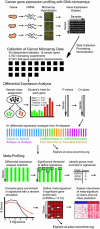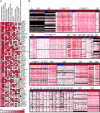Large-scale meta-analysis of cancer microarray data identifies common transcriptional profiles of neoplastic transformation and progression
- PMID: 15184677
- PMCID: PMC438973
- DOI: 10.1073/pnas.0401994101
Large-scale meta-analysis of cancer microarray data identifies common transcriptional profiles of neoplastic transformation and progression
Abstract
Many studies have used DNA microarrays to identify the gene expression signatures of human cancer, yet the critical features of these often unmanageably large signatures remain elusive. To address this, we developed a statistical method, comparative metaprofiling, which identifies and assesses the intersection of multiple gene expression signatures from a diverse collection of microarray data sets. We collected and analyzed 40 published cancer microarray data sets, comprising 38 million gene expression measurements from >3,700 cancer samples. From this, we characterized a common transcriptional profile that is universally activated in most cancer types relative to the normal tissues from which they arose, likely reflecting essential transcriptional features of neoplastic transformation. In addition, we characterized a transcriptional profile that is commonly activated in various types of undifferentiated cancer, suggesting common molecular mechanisms by which cancer cells progress and avoid differentiation. Finally, we validated these transcriptional profiles on independent data sets.
Figures



References
-
- Dhanasekaran, S. M., Barrette, T. R., Ghosh, D., Shah, R., Varambally, S., Kurachi, K., Pienta, K. J., Rubin, M. A. & Chinnaiyan, A. M. (2001) Nature 412, 822-826. - PubMed
-
- Luo, J., Duggan, D. J., Chen, Y., Sauvageot, J., Ewing, C. M., Bittner, M. L., Trent, J. M. & Isaacs, W. B. (2001) Cancer Res. 61, 4683-4688. - PubMed
-
- Luo, J. H., Yu, Y. P., Cieply, K., Lin, F., Deflavia, P., Dhir, R., Finkelstein, S., Michalopoulos, G. & Becich, M. (2002) Mol. Carcinog. 33, 25-35. - PubMed
-
- Magee, J. A., Araki, T., Patil, S., Ehrig, T., True, L., Humphrey, P. A., Catalona, W. J., Watson, M. A. & Milbrandt, J. (2001) Cancer Res. 61, 5692-5696. - PubMed
Publication types
MeSH terms
Grants and funding
LinkOut - more resources
Full Text Sources
Other Literature Sources

